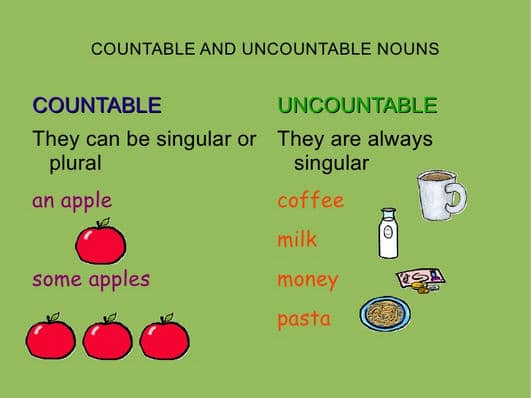By Laura Payne

By the end of grade school, children will have learned that not all nouns behave the same way when it comes to pluralization. Nouns can be separated into two different types: those that can be pluralized and those that can’t. Nouns that can be pluralized are called count nouns, and nouns that can’t be pluralized are called non-count nouns.
It is important for children to be able to differentiate the two types of nouns because they are quantified differently, and they take different modifiers. You can help your children with count and non-count nouns by reviewing some basic guidelines with them.
Count Nouns
Count nouns are exactly what their name implies -- nouns that can be counted; for example, one duck, two ducks, three ducks. They usually end in an S in the plural form, with occasional exceptions such as octopi.
Here are some more count nouns:
hand table chair apple word house pond bed boy girl bike
Non-Count Nouns
Non-count nouns cannot be counted by numbers and can’t be pluralized; for example, one rice, two rices, three rices is incorrect. Non-count nouns are quantified with amounts instead of numbers; for example, some rice, more rice and less rice.
Here are some more non-count nouns:
milk wood coal weather furniture flour oxygen sugar salt
Non-count nouns can also be quantified by using a measurement plus the word of before the noun; for example, a cup of rice, two cups of rice, three cups of rice.
Modifying Count and Non-count Nouns
Count nouns can take the modifier a or an, and non-count nouns can’t. Here are some examples:
Acceptable Unacceptable
an apple an oxygen
a table a furniture
a girl a sugar
Count nouns can use the modifier many, and non-count nouns can’t. Non-count nouns use the modifier much instead. Here are some examples:
Acceptable Unacceptable Acceptable
many houses many coals much coal
many boys many salts much salt
many bikes many flours much flour
Practicing Nouns
A great place to practice count and non-count noun usage with your children is the grocery store. It is as easy as asking them how many or how much of each item they think you should purchase because they will have to respond with a numeral or an amount.
Special Note: There are a few nouns that can be considered both count and non-count depending on their intended meaning. When the meaning is specific, the noun is a count noun; when it is abstract, it is a non-count noun.
She had many difficulties finding a job. She got a job without much difficulty.
He loved his many experiences in Africa. He has much experience with travel.
About Laura Payne
A self-confessed language nerd, Laura Payne is the mother of two boys, and she is a part-time English teacher. She has also done freelance writing about several topics including the structure and grammar of English.

